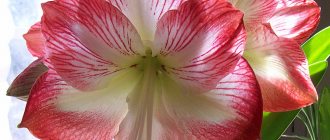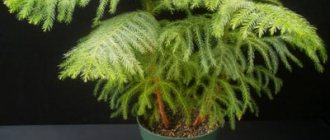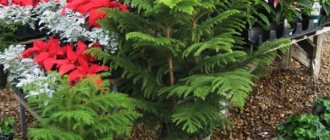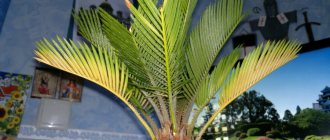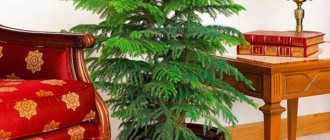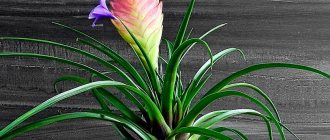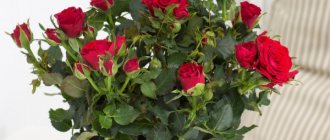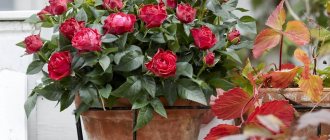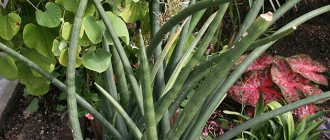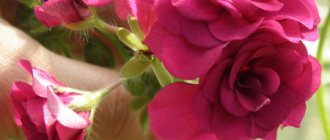Most gardeners know Araucaria under the nickname of indoor spruce. This ancient, relict plant is perhaps the only coniferous crop that can really be grown at home. An elegant giant with a thin trunk, beautiful large branches, inimitable textures, and special soft needles looks impressive. But you have to “pay for” beauty with very careful care. Like all conifers, araucaria loves cool winters, requires a special humidity regime and is intolerant of even small mistakes in care.
Araucaria is an indoor Christmas tree. © The Sill
Description of the plant
Araucarias are most often purchased as an alternative to cut live trees or artificial Christmas trees for the winter holidays. But the plant is much more promising than just an elegant indoor Christmas tree. If you need a giant from the category of evergreen stars, there is a suitable cool place; you cannot find a more spectacular candidate than araucaria.
Araucaria (Araucaria) from the family of the same name Araucariaceae is one of the most ancient coniferous plants on the planet, a forest-forming giant in the highlands of the Andes, common on numerous islands of the southern hemisphere. These are powerful monoecious trees up to 65 m or more in height. In indoor format, the size of araucaria is limited by the height of the ceiling.
Whorled, horizontal, often slightly drooping at the ends, triangular branches seem graceful and strikingly massive. An ideally straight, thin trunk with grayish bark and widely diverging branches in whorls allow Araucaria to form a tiered, structured, transparent, strict cone-shaped crown. The side branches are long, straight, drooping.
Araucarias are captivated by the density of spirally growing needles, which after 30-40 years change shape from long-needle to scaly. Indoor araucarias “have time” to show off only with “young”, long, ribbed, soft awl-shaped needles, curved upward, from 1 cm in length with a width of only 1 mm. A rich dark green shade with a bluish lower edge is characteristic of all araucarias, except for the completely bluish-blue decorative forms of glaucus.
The plant does not bloom in rooms; you can admire the long thin male rafters and hemispheres of female cones only in botanical gardens.
What does a homemade Araucaria tree look like?
The specificity of the growth of araucaria as a houseplant is such that it will take quite a long time to reach its maximum height, so it can be grown indoors for ten years. The tree has stiff branches with thin, needle-like foliage that grow almost horizontally. At the same time, the needles of indoor culture are quite soft, about 2 cm long. The leaves, both in nature and in the home environment, have a soft green color. The crown has the shape of a pyramid.
Look and compare in the photo what indoor araucaria looks like and growing in its natural habitat:
The culture is mainly dioecious, i.e. male or female cones grow on it:
They are quite heavy; the weight of one of them, the Chilean araucaria (Araucaria araucana), is about 1.5 kg. The female fruits of the coniferous plant are rounded, soft greenish in color, with tightly fitting lobes, about 20 cm in diameter, and the male fruits are slightly elongated, about 15-20 cm long. They have seeds under the scales. Sometimes there are monoecious units or those that change sex over time. It is worth noting that araucarias as such do not have flowers in the direct sense of the word (like other coniferous crops) - they do not bloom. In this case, the cone is simultaneously both a fruit and an inflorescence.
It is interesting that the seed of this tree in most cases is quite edible, it can be eaten, which is successfully used by the Brazilians. They stew the seeds from the cones, fry them and put them in pies. But after sawing, Araucaria trunks are used to make furniture. This wood is considered one of the best. In addition, pine needles perfectly purify the air by releasing phytoncides - the plant also performs a disinfecting function indoors.
Types of indoor araucarias
Of the 19 species of araucaria in indoor format, only one has really taken root - araucaria heterophylla, known throughout the world as Norfolk pine .
Thanks to the experiments of Dutch breeders, other varieties with a height of 2 to 4 meters occasionally appear on sale:
- Araucaria angustifolia, or Brazilian candelabra tree (Araucaria angustifolia), characterized by horizontal branches with unusual whorls at the ends and rapid falling of the lower branches, due to which the crown takes on an umbrella shape;
- Hanstein's araucaria (Araucaria hunsteinii) with denser tiers of branches and horizontally spaced lateral branches.
Variegated araucaria (Araucaria heterophylla). © dcloudtechnology
Araucaria angustifolia, or Brazilian candelabra tree. © cycadales
Araucaria hunsteinii. © conifersociety
Types of araucaria: photo and description
Today, there are 19 species of araucaria plants that grow on the Australian continent, on the islands of New Guinea and Caledonia, and Norfolk. Two more varieties of this culture live on the American continent. Many of them reach a height of 50 m, although there are some growing up to 60 m, or even up to 90 m. Only a few of all types of araucaria are grown in flowerpots and greenhouses. The most interesting types of culture are:
Araucaria araucana.
Araucaria bidwillii.
Araucaria brasiliana.
Araucaria angustifolia.
Araucaria heterophylla.
Below are photos with the names of some types of araucaria and their short descriptions:
Araucaria heterophylla (indoor fir) Araucaria heterophila is the most popular human-cultivated plant from the genus Araucariaceae. It was brought from Norfolk Island. In the wild it reaches 60 m in height; indoors it will gain height very slowly and will not grow more than 1.5 m. Thanks to its branches and foliage, araucaria is called the “house Christmas tree”. It has a brownish flaky bark, a crown growing in the form of a pyramid, collected from hard branches with small greenish leaves-needles 2 cm long. On the tree trunk, the branches grow whorled, densely, forming a kind of spiral. Small short (no more than 8 cm) scales appear on young shoots of branches.
Araucaria brasiliana (Brazilian araucaria) and Araucaria angustifolia (angustifolia) can become indoor plants. Despite the fact that wild specimens have a height of about 50 m, at home they will grow no more than 3 m. The thin branches are densely covered with short, triangular-shaped emerald leaves. Characteristic features of these plants are the “drooping” tips of the branches, drooping to the bottom. The leaves of the tree are bright green, linear-lanceolate, no more than 5 cm long.
The Christmas tree species Araucaria araucana (Chilean araucaria) is found in Chile and western Argentina. This is a plant that grows in natural conditions up to 60 m with a trunk diameter of about 1.5 m. The crown has the appearance of a wide pyramid. The lower branches lie on the ground, and over time they die and fall off. The branches grow purely horizontally, and quite slopingly. They are slightly “drooping” in old trees and are all densely covered with hard greenish triangles, reminiscent of a monkey’s tail. The culture loves good light, high air humidity, sufficiently moist (not swampy) soil containing many nutrients. Easily tolerates droughts and light frosts. The large seed of the plant is eaten, it is tasty and nutritious.
This is only a small fraction of all known types of crops, but even they are enough to create a beautiful greenhouse or flower garden at home, provided they are properly cared for.
Growing conditions for indoor araucaria
Araucaria is only slightly better adapted to relatively warm wintering than other conifers. A place in a cool winter garden or greenhouse is also more suitable for it than in a room.
Lighting and placement
Indoor Araucaria spruce is afraid of direct midday sun only at the height of summer. The brighter the lighting, the less the plant stretches, the denser the whorls grow, the longer and more magnificent the drooping side branches. Any lack of light causes irreversible damage to the needles and loss of lower branches. The ideal place for araucaria during the active growing season is considered to be eastern and western windows. In winter, plants need to be illuminated up to twelve hours of daylight or moved to a southern windowsill.
For normal development of the plant, it is necessary to regularly turn the pot. When using artificial lighting, you need to take into account that the only option for placing lamps is on top of it+.
Even for young araucarias, it is always worth remembering the scope of the foliage. The branches should not rest against walls or other surfaces; the plant needs space and free air circulation. This plant is intended for decorating only large rooms.
Choosing the right place
sunlight for normal development, but direct rays are not at all beneficial. Therefore, it is better to keep the plant on a western or eastern window. For uniform growth and development, the tree needs to be turned to the light, first on one side, then on the other after about 5-7 days.
In summer , the araucaria plant can be kept outside, being sure to protect it from the sun and precipitation. At home, the flow of fresh air is ensured by frequent ventilation of the room.
Caring for araucaria at home
Watering and timely increase in air humidity are the key to success with araucarias. The plant often unpleasantly surprises even experienced gardeners.
Watering and air humidity
Araucaria should be protected from any “water” stress, avoiding dampness or drying out of the soil. It is better to regulate watering by allowing the substrate to dry thoroughly in the top layer, up to 4 cm, and immediately draining the water released into the trays. In winter, the soil is dried a few centimeters deeper, reducing the amount of water when watering.
Araucaria is watered only with lukewarm (3-5 degrees higher than the air in the room) and soft water.
The higher the air humidity, the easier it is for araucaria to adapt to room conditions. If these indicators drop below 50%, araucaria cannot tolerate proximity to batteries, immediately reacting with drying out and yellowing of the needles, especially at the ends of the branches. Frequent misting is the best method to compensate for heat and dry air. But you can only spray the crown at temperatures above 18 degrees, and not everyone can afford to spray it up to 3-5 times a day, so it is better to stabilize the conditions using a humidifier or trays with wet pebbles, moss, and expanded clay.
Araucaria does not tolerate dust. If you do not spray and wash the plant regularly, the needles will fall off.
Top dressing and fertilizer composition
Only special fertilizers for coniferous plants are suitable. Araucarias do not tolerate phosphorus. Fertilizers are applied exclusively during the period of active growth, in liquid form, dissolved in water for irrigation, in a standard dosage, every 2 weeks (or according to the manufacturer’s instructions).
For araucaria, it is better to choose a special substrate for conifers. © Rakutenuchg
Pruning and replanting araucaria
The plant does not tolerate cutting off the top, completely stopping vertical growth. You can keep araucaria “in shape” only with proper care.
This plant can only be transferred, without replacing the soil and without washing it off or shaking it off from the roots to preserve mycorrhiza. Exposing the roots is destructive. Change containers as needed - when the earthen ball is completely entwined with roots. The norm is 1 transplant every 3-4 years.
With the help of tight containers, the growth of the plant and its height are restrained. Araucarias do not tolerate excess space; it is better to limit the pots to medium sizes; when the maximum is reached, simply cut off the root ball (no more than half). You need shallow, fairly flat pots, with increments of 2-3 cm in size.
For the plant, it is better to choose a special substrate for conifers or a combination of turf, leaf soil, coniferous soil, humus and sand (2:1:1). The addition of bark and pine litter will not be superfluous even for ready-made substrates. A neutral reaction is acceptable, but slightly acidic and acidic soil mixtures with a pH of 3.0 to 5.5 are preferred.
Care at home
The technology for keeping plants at home has its own peculiarities. Attention, care, and proper care should appear along with the brought tree.
Advice . It is important to remember that the adaptation time after purchase is a difficult period in the life of a plant. You can make it easier by providing the plant with the necessary lighting, temperature, and watering. At this time, it is better to touch him less often.
After successful relocation, a new layer of branches appears on the tree every year. In order for them to form a symmetrical figure, you need to rotate the plant weekly. The lump of earth should never dry out. Otherwise, the lower branches will dry out and fall off.
This video briefly describes the main points for caring for domestic araucaria:
Below are the main requirements for the quality development of Araucaria.
Lighting, temperature
The plant should receive bright light without direct sunlight.
The best conditions are considered to be the ability to illuminate the tree from different sides in spacious rooms.
Summer temperatures should not exceed 22. In winter 16°.
It is important to know: cool, fresh air without drafts are optimal conditions for plant development. The lack of lighting in winter is compensated by the use of fluorescent and LED lamps.
Attention! Do not place pots with plants near heating devices. With a lack of lighting and dry air flow, the branches turn yellow and the needles fall off.
Priming
The optimal soil composition for a plant is considered to be a mixture of turf, leaf substrates, peat, and sand with a slightly acidic reaction.
You can use the composition of the same parts of turf, coniferous soil, humus, peat, or purchase formed soil for coniferous plants.
Watering, fertilizing
Water the plant with settled, soft water.
The watering regime is chosen so that the soil is never dry, but without excess moisture.
Dry air is reduced by regularly spraying the needles twice a day. Along with watering, fertilize with complex mineral fertilizer once every 20 days. In winter, fertilizing and watering are done less.
Transfer
It is carried out in the spring, early summer. Large trees are transferred to large pots with equipped drainage, using a method of careful handling. Such activities slow down the growth rate.
Advice. The signal for the need for replanting is the size of the root ball that has filled the entire volume of the pot. The plant should not be disturbed unless necessary.
Reproduction
For this purpose, apical, stem cuttings, and Araucaria seeds are used. The cutting method is simpler and produces results faster. Cuttings from side branches often produce asymmetrical development of the tree.
The apical shoot is cut just below the node of the lateral branches.
It is dried, cleared of resin, and planted in the greenhouse soil.
Rooting occurs after 4 months.
Seed propagation with fresh seeds is carried out in small cups. Shoots appear for a long time, unevenly. They develop very slowly.
Diseases, pests and problems in growing
Indoor spruce easily loses its needles, turns yellow, becomes exposed below, becomes deformed and stretches. Damaged needles cannot be restored, so critical mistakes in care should be avoided at all costs.
In a weakened state, when taken out into the garden, araucaria can suffer from any pests of coniferous plants; mealybugs and spider mites are often found indoors. Control measures should be combined with the use of strong systemic insecticides.
You can try to grow indoor spruce from seeds, but they lose their viability extremely quickly
Araucaria - interesting facts
Even owners of homemade Christmas trees do not know everything about them, and perhaps the following information will be surprising to many:
- This tree was found back in the Mesozoic period.
- During the Jurassic period, araucaria were the main food for herbivorous sauropod dinosaurs.
- The beneficial properties of araucaria are known and they are associated with the fact that conifers secrete phytoncides - substances that fight germs and bacteria in the air.
- The seeds of this tree can be eaten.
Araucaria propagation
You can try to grow indoor spruce from seeds, but they lose their viability extremely quickly. Sowing is carried out immediately after their collection, in a sand-peat soil mixture, superficially, under film or glass. Germination will take several months even at a stable temperature of 25 degrees. Slowly developing seedlings require very careful care and are sensitive to any stress.
Cuttings using the tops of branches cut several centimeters below the whorl of lateral branches or re-rooting the tops of spruce trees are very difficult; araucarias take root poorly. Drooping small side branches, broken off at the heel, often develop asymmetrically, so they are used as a last resort.
After treatment in the rooter, the cuttings are buried up to the first whorl in peat tablets or a disinfected light substrate. And they are kept in a greenhouse at a temperature of about 25 degrees for 4 months.
Araucaria - description
In its natural environment, the tree can reach a height of up to 50-60 m, but sometimes real giants can be found. Domestic representatives do not grow more than 2 m. The main characteristics of the Araucaria indoor plant include the following information:
- The branches on the trunk are arranged in whorls and when viewed from above, they will look like a star. 1-2 whorls grow per year.
- Along the entire length of the branches there are short and needles. Their color can vary from bright green to gray.
- The tree grows slowly and can be kept indoors for 8-10 years. An adult plant can be transplanted outdoors.
Watering
For irrigation, soft, settled water at room temperature is required. You can use rain water or boiled water. Watering should be regular; the soil should not be allowed to dry out or become waterlogged. In winter it is reduced, especially when the tree is kept in cool conditions.
If watering should be moderate, then the air humidity is maintained sufficiently high, otherwise the side branches will begin to dry out. To create optimal conditions, the tree is constantly sprayed, at least once a day, both in summer and winter.
Succinic acid and epin can be added to the water for spraying
In addition, the plant can be placed in a tray filled with pebbles or expanded clay, keeping them wet at all times. The soil in the pot can be covered with moss, constantly moistening it.
Transfer
The plant is replanted in early spring as needed - as soon as the roots fill the entire volume of the pot, the ephedra is simply transferred to a larger container. Araucaria is very difficult to tolerate transplants. Typically, spruce is replanted once every three to four years.
Pots for conifers are chosen to be voluminous and always wide. Drainage is arranged at the bottom of the container, since the plant does not tolerate stagnant moisture. In a pot that is too small, the tree will grow very slowly or stop developing altogether.
Reproduction
Indoor spruce trees can be propagated either by seed or by cuttings. Seeds propagate araucaria only in the presence of fresh planting material. The seeds are sown in boxes with nutritious and moist soil and covered with moss on top so that the soil does not dry out longer. The boxes should be kept in a bright room, where the air temperature is about +20 degrees. Seedlings grow very slowly and require constant care.
Young plants must be protected from the sun, and when the seedlings grow a little, they are thinned out, leaving a distance of about 10 cm between them. Only after a year can young plants be planted in separate pots that are no more than 8 cm in diameter.
Since caring for seedlings is very troublesome, many gardeners prefer to propagate indoor spruce by cuttings. Shoots that have not yet become lignified from the top of the tree are suitable for cuttings. You can also use side shoots, but such decorative trees will not grow from them.
Selected shoots are cut with a sharp tool in the middle of the branch and left to dry for a day. After this, the sections are cleaned and treated with crushed coal.
